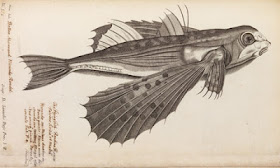Finding the
publisher of the fish image is pretty easy.
By now I assume you all know about Google's Search-by-image, and can drag that
image into the Image search box to discover that it's from the book Historia
Piscium by John Ray and Francis Willughby, published in 1686 by the Royal
Society in the UK. The Royal Society
recently released a set of online images from that text (along with select images from many other classic texts they’ve published over the last 400 years).
 |
| Image from Historia Piscium, by John Ray and Francis Willughby (1686), courtesy of the Royal Society |
With that search, we quickly learn (from any of the multiple
hits found by this search) that the book was published by the Royal Society,
which spent way too much money on its production, leaving it with insufficient funds
for the production of Isaac Newton’s book,
The book, Historia
Piscium, was written originally by Francis Willughby. This was all fairly straight-forward.
To dive more deeper into question 3, we have to follow-up
with a search on the background of the authors.
A quick search for [ Francis Willughby football ] leads you to his definitive
study of games, Francis Willughby's Book of Games. In
that text, if you search for “football” you’ll find this astounding passage:
"They blow a strong bladder and tie the neck of it as fast as they can, and then put it into the skin of a bull's cod and sew it fast in". And later, in that same text he writes: "The harder the ball is blown, the better it flies. They used to put quicksilver into it sometimes to keep it from lying still.”
In other words, early footballs were made from a bull’s
privy parts, and at least occasionally had quicksilver (mercury) added to slosh
around inside. Since mercury is so
heavy, it would make the football fly rather erratically and wiggle back and
forth on the ground, long after the last player had touched it! I imagine this made tossing the ball rather
difficult, and it probably made the game hysterically funny to watch, as the
ball would seem to have a life of its own.
For question 4, it’s also not hard to search for [historia
piscium publication] and find that the money for publication of the NEXT book
by the Royal Society was fronted by Edmund Halley, he of Halley’s comet
fame.
Reading around in this hit list for a bit, you'll find that Halley had a longstanding relationship with Newton, and was
really responsible for getting Newton to finish writing up his results in his
book, Philosophiae naturalis principia
mathematica (usually shortened to Principa Mathematica), a book which
arguably changed the course of science by giving shape to a strong mathematical
treatment of physical phenomena.
And Halley was no slouch himself. Among other things, in 1691, Halley built a
diving bell and dove 60 feet in the River Thames, and remained down for 90
minutes. His bell was of little practical use as it was very heavy, but he was later
able to extend his underwater time to over 4 hours. However, not being aware of the practical value
of his friend Boyle’s laws of gas
pressure changes, Halley suffered one of the earliest recorded cases of middle
ear barotraumas when he rose too rapidly from the depths of the Thames.
This factoid is interesting to me right at the moment as I'm diving in Belize, making sure to avoid this same kind of painful middle-ear damage that Halley suffered while doing his studies.
Search lessons: One
of the more interesting aspects of being able to do this kind of linking /
discovery search is to find unexpected connections. James Burke is probably the modern master of
finding the quirky, odd, but sometimes essential connections between
ideas.
For a student learning about the history of ideas (or for an
adult learner just trying to understand the world more broadly and more
contextually), this kind of search is a marvelous tool. I hope you find these kinds of search
challenges as interesting as I do.
Knowing the connections between the Royal Society, Halley, Newton and
Willughby (as both ichthyologist AND sports fan) just made my mental picture of
the 17th century a bit more memorable.
May all your searches do the same!
Search on!
Really amazing! :)
ReplyDeleteyour blog has inspired me and improved my searching, but there is one photo that has completed eluded my efforts to find out more about it, and has also eluded others ... if you google "little girl and camel laughing" there's a delightful picture that comes up in top of the results. As far as I know, no one knows who took it or anything about where it was ... we'd ALL love to know.
ReplyDelete